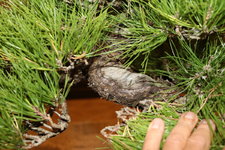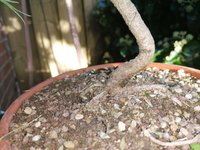You are using an out of date browser. It may not display this or other websites correctly.
You should upgrade or use an alternative browser.
You should upgrade or use an alternative browser.
Thicken Trunk With Wire?
- Thread starter dbonsaiw
- Start date
Wires_Guy_wires
Imperial Masterpiece
Srt8madness
Omono
Funny the thing about wrapping wire. I have a crepe myrtle sapling that has been developing a great nebari, like I'm sitting there wondering how it is naturally growing so radially. I had to repot this weekend because it kept falling over, and discovered where I had put a root tourniquet on when I planted 
 .
.
So yes to wrapping wire to encourage a new root system, but I wouldn't do it on the trunk.
So yes to wrapping wire to encourage a new root system, but I wouldn't do it on the trunk.
Brian Van Fleet
Pretty Fly for a Bonsai Guy
I know your thread is about a seiju elm, but some pine examples have popped up as well. Look at my JBP as an example, here it is in spring of 2022. I have owned this tree for 15 years now, and it didn’t really show wire scars when I bought it in 2007, but obviously the trunk had been wired for shape at some point, probably sometime around 2000 +/-. The scars aren’t obvious now, before scrolling on…can you see them?

Look again, they’re traced in red below:

The front is ok, and likely the scars are not noticeable.
Here’s where the trouble starts. A few years ago I noticed a small Shari open up on the back of the trunk at the first bend. Over time, the dieback continued…right along the wire scar. Yes, it adds character, and I’m fortunate its on the back…but if it continues to open up, it may end up killing the tree entirely.


Look again, they’re traced in red below:

The front is ok, and likely the scars are not noticeable.
Here’s where the trouble starts. A few years ago I noticed a small Shari open up on the back of the trunk at the first bend. Over time, the dieback continued…right along the wire scar. Yes, it adds character, and I’m fortunate its on the back…but if it continues to open up, it may end up killing the tree entirely.

Paradox
Imperial Masterpiece
That's amazing from wire scaring that old..
Srt8madness
Omono
As I understand your post, this was wired for shape but not wired for thickness.I know your thread is about a seiju elm, but some pine examples have popped up as well. Look at my JBP as an example, here it is in spring of 2022. I have owned this tree for 15 years now, and it didn’t really show wire scars when I bought it in 2007, but obviously the trunk had been wired for shape at some point, probably sometime around 2000 +/-. The scars aren’t obvious now, before scrolling on…can you see them?
View attachment 457904
Look again, they’re traced in red below:
View attachment 457907
The front is ok, and likely the scars are not noticeable.
Here’s where the trouble starts. A few years ago I noticed a small Shari open up on the back of the trunk at the first bend. Over time, the dieback continued…right along the wire scar. Yes, it adds character, and I’m fortunate its on the back…but if it continues to open up, it may end up killing the tree entirely.
View attachment 457906
The former seems like the cost of doing business if you want movement in your tree. But if done for the latter, it seems even more risk is being put onto the tree.
Brian Van Fleet
Pretty Fly for a Bonsai Guy
Correct. The best way to add movement to a trunk is through pruning. If wire is used, it should be removed before scarring sets in…as in well before the trunk swells around it, then allow the trunk to thicken with movement, but without wire. So, wire used to thicken a trunk is risky.As I understand your post, this was wired for shape but not wired for thickness.
The former seems like the cost of doing business if you want movement in your tree. But if done for the latter, it seems even more risk is being put onto the tree.
Crazy Diamond
Omono
Its one of those things that if done correctly and with the right amount of time can give a nice look to the trunk like the Brian tree, I think its pretty common in exported Japanese pines; done to thick up faster the trunks (I dont know how its viewed among the japaneses bonsai growers, if its something they only do in exported cheaper material or also in their trees to sell in Japan) also could be a interesting thing to do in junipers to get crazy live veins
BillsBayou
Chumono
Wire can be wrapped around the base of a maple or elm to not only thicken the trunk, but to create new lateral roots. No personal experience, but a local artist did this with his maple. Takes a while, but his results were great.
There is a Drake elm on my bench that needs this done. Maybe I'll anneal some thick copper and get that project started.
There is a Drake elm on my bench that needs this done. Maybe I'll anneal some thick copper and get that project started.
Crazy Diamond
Omono
Well yes thats basically an airlayer by strangulation a lot of people do it with steel washers or tiles with holesWire can be wrapped around the base of a maple or elm to not only thicken the trunk, but to create new lateral roots.
Nah. The bulge is hidden under the canopy and not worth losing that branch. And it looks like a mini bee hive, so I like it.Maybe you can cut the branch off before the bulge and grow a new one
Always great when there are clear definitive statements in bonsai. Thanks.Correct. The best way to add movement to a trunk is through pruning. If wire is used, it should be removed before scarring sets in…as in well before the trunk swells around it, then allow the trunk to thicken with movement, but without wire. So, wire used to thicken a trunk is risky.
Similar threads
- Replies
- 29
- Views
- 9K
- Replies
- 4
- Views
- 538



